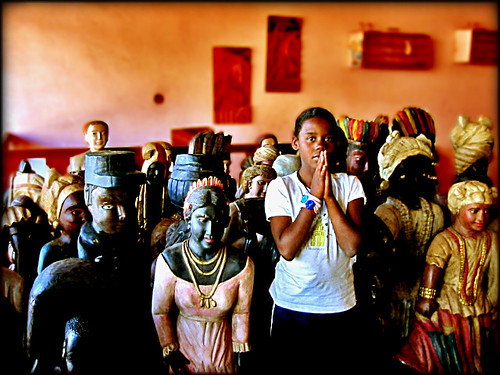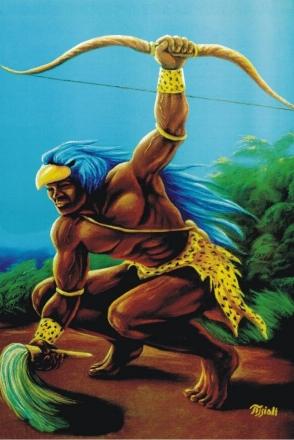 Picture taken by Carf. September 27,2005.
Picture taken by Carf. September 27,2005.“The Candomble is the religion that provides the spiritual foundation and super structure of Bahian life” -Sheila S. Walker
Background Information
The New World and the Old World contributed to cultures that began to establish in various parts of America. In Brazil, derived religions from Africa started to take place and influence the Brazilian culture. Africans were brought to the New World due to the labor shortage that diseases were causing. Many indigenous people began to die because of the lack of biological immunities. Therefore, the slave trade of Africans to the Americas began since Africans adapted to any type of environmental changes and had better biological immunities. Throughout the time African slaves rapidly replace the indigenous people, their labor demonstrated that they were efficient and caused the increase of captives to Brazil.
According to Fryer, from about 1530 Brazil was colonized. Many changes occurred after Africans were transported to Brazil, many began to die because they did not have health care treatment and were overworked. However, as the population was declining in Brazil more African captives were brought. Consequently, Brazil’s population increased dramatically, “By 1849 there were more than 78,000 slaves… out of a total population of 206,000, and 60% of them were of African birth; this was the largest urban slave population in America” (Fryer 6). Because of the massive African population in Brazil, the emergence of a new culture in music and religion began.
On the other hand, African captives began to make a change regarding the way they were treated by Europeans. Slave rebellions arouse in order to show resistance against the way they were being oppressed by Europeans. The slaves that began the revolts were called Quilombos. According to Voeks, the famous uprising was in 1935 in Salvador. Although, slavery was abolished in 1888, Europeans felt that they still had that superiority and thus it caused the uprising of African captives.
Origins of Candomble
After, the revolts religions began to erupt. The Yoruba religion influenced the formation of the Candomble religion. Yoruba slaves and freedman introduced the Candomble religion. The Candomble religion was form with a set of believes, cosmology, and practices. Cosmology is a spiritual universe circumscribed by the Orixas (Voeks 52). Yoruba introduced different religions and was the dominant out of all the religion. As described by Voeks, “the Yoruba a rich and complex cosmology, a rigidly defined social structure” (Sacred Leaves of Candomble 51).
Yoruba was the central focus of many religions in the Bahia. Yoruba had a major influence within ethnic and cultural messages that obtained the Yoruba culture (Voeks 53). Candomble is form by different cultural fundamentals but comes from the same religion.
Orixas
The Orixas are a cultural element from the Candomble religion. The Candomble is form by various Orixas. Orixas are gods that are connected with different realms of nature such as water, air, earth, and forest. According to Voeks, Orixas are complemented with certain features such as taboos, offerings, sacred foods, preferred time of worships, icons, and geographical locations (Sacred Leaves of Candomble 57). Each of these Orixas has an accoutrement that can be identify. The Orixas have certain metals and colors that define their identity. Most importantly each Orixa has a discursive practice. Thus, every Orixa have a significance that lies behind their costumes, body movements, gestures, and rhythms. Most importantly they embody the strength and foresight of their adherents (Voeks 56). The most prominent Orixas:
1. Exu
2. Ogum
3. Oxossi
4. Omolu
5. Ossain
6. Oxum
7. Logum Ede
8. Oxumare
9. Lemanja
10. Xango
11. Lansa
12. Nana
13. Obatala
In addition, every Orixa have a characteristic that convey a symbol, which is demonstrated by both the body movements while performing and the accoutrement. The African deities also called as Orixas are identified with more than one Catholic saint.
Music
Music is an essential characteristic of Candomble. The music engages the performer and the audience into the symbolic dances of Candomble. According to Miller Chernoff, “a dancer converses with the music... a dancer and an orchestra cut across each other’s movements, as if the dancer is a apart of the ensemble” (Rhythms of Resistance qtd 20). Candomble is a religion that influenced the lives of those captive slaves and to Afro- Brazilians.
As Fryer puts it, “Originally this was a music of resistance, whose primary function in the teeth of persecution was to keep Africa and African deities alive in the minds and hearts of captive Africans” (Rhymes of Resistance 9). As mentioned music plays an important role in the Candomble ceremonies. However, the use of instruments is what makes the performance outstanding and putts across the meaning of each Orixa. For instance, some instruments such as the three conical drums (rum, hum, rumpi) also known as abatiques, come from West Africa in which it provides a single repeatedly steady rhythm (Fryer 19). Also two other instruments that are derived from Yoruba are essential to the music of Candomble. The first one is called agogo and the other is ga both are drums. Both instruments set the rhythm at the beginning of the song.
In addition, Candomble had a tremendous influence in Brazil and it still does. Candomble is a form of tradition and was a religion to Afro- Brazilian populations and African captives that once were slaved by Europeans. Therefore, the significance of each Orixa will be discussed.
Work Cited
Monica Mendez










